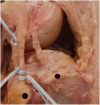Anterolateral corner of knee: Current concepts
- PMID: 39931146
- PMCID: PMC11808268
- DOI: 10.1002/jeo2.70172
Anterolateral corner of knee: Current concepts
Abstract
The anatomy of the antero-lateral corner (ALC) has been the topic of recent interest, as evidenced by the increasing number of publications. Knowledge needs to be improved amongst clinicians regarding the anatomy and biomechanical function of this vital structure and its implications on the rotational stability of the knee. There has yet to be a consensus on the role of surgical procedures and their indications for addressing the instability associated with the injury to these structures. Through this article, the authors have tried to outline the existing literature regarding Anterolateral knee instability, the associated structures, and the management of its injuries, emphasising the role of the anterolateral capsule and reconstructive procedures in combined ligamentous knee injuries.
Keywords: anterolateral capsule; anterolateral instability; anterolateral ligament; knee; rotatory instability; rotatory laxity.
© 2025 The Author(s). Journal of Experimental Orthopaedics published by John Wiley & Sons Ltd on behalf of European Society of Sports Traumatology, Knee Surgery and Arthroscopy.
Conflict of interest statement
The authors declare no conflicts of interest.
Figures



References
-
- Getgood A, Brown C, Lording T, Amis A, Claes S, Geeslin A, et al. The anterolateral complex of the knee: results from the International ALC Consensus Group Meeting. Knee Surg Sports Traumatol Arthrosc. 2019;27(1):166–176. - PubMed
-
- Alessio‐Mazzola M, Formica M, Russo A, Sanguineti F, Capello AG, Lovisolo S, et al. Outcome after combined lateral extra‐articular tenodesis and anterior cruciate ligament revision in professional soccer players. J Knee Surg. 2019;32(09):906–910. - PubMed
-
- Alm L, Drenck TC, Frosch K‐H, Akoto R. Lateral extra‐articular tenodesis in patients with revision anterior cruciate ligament (ACL) reconstruction and high‐grade anterior knee instability. Knee. 2020;27(5):1451–1457. - PubMed

